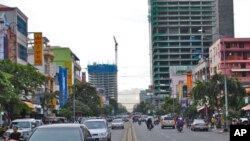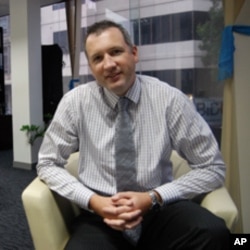Ten years ago, the infrastructure in Cambodia's capital, Phnom Penh, was in poor condition. Power outages were frequent. Heavy rains and poor telecommunications slowed commerce and limited outside contacts.
But in the past decade, new roads and high-rise buildings have changed the landscape. And in July, the nation's first stock exchange and a multiplex cinema opened.
Phnom Penh has several active cinemas dating from the 1950s, but they mainly screen the small number of domestically produced films or translated Thai imports. Pirated DVDs have cut into their business, keeping people at home.
Until July, the only way to see the latest Hollywood blockbuster in a theater was to catch a plane to Thailand or Vietnam.
But now, for $6, one can go to the new air-conditioned, three-screen Legend cinema in central Phnom Penh, grab a box of popcorn and settle down to watch Kung-Fu Panda 2 in 3D (three dimensions).
Michael Chai, a director at WesTec Media, which built the cinema, is aiming at a young, internet savvy Cambodian market.
“If I look at Facebook for example, I've been looking at the numbers. In May 2010 there were only about 50,000 of them on Facebook. May 2011 we had almost 400,000. So that figure alone, that kind of growth, speaks a lot already. And most of them on Facebook are communicating to each other in English.”
While it would take most Cambodians several days to earn the price of the $6 ticket, the owners are betting that a growing middle-class will become regular customers.
Prum Seila, a 24-year-old office worker, is in Chai's target demographic. Just a few weeks after the theater opened, Seila has visited twice.
“I went there to see the Transformers 3. And I've never seen 3D in my life. I just saw the Transformers 3, and I know that in Transformers 3 there is a scene in Cambodia and [so] we should have seen it. And it is just kind of supporting stuff like that in Cambodia," Seila says.
The growth in Phnom Penh has been fueled in part by garment factories, an economic pillar in Cambodia, that are located around the capital, drawing young workers to the city.
The jobs and new technology are changing things quickly. A recent survey indicates more than 90 percent of young Cambodians have access to a mobile phone. Internet usage, though low, has doubled in a year to 6 percent.
Prum Seila, the eager movie-goer, grew up in the capital. He says he and his friends now spend their free time hanging out in food halls, scores of gleaming new coffee shops and entertainment venues named Diamond Island and Dreamland, where you can sing karaoke.
He says shopping is popular.
“The people like me they have jobs, they have money," he says. "They save money to buy expensive brands like Apple, iPhone. Some of the girls they try to buy the clothes from internet, from Facebook.”
In July, officials opened the country's first stock exchange. Although no companies have yet listed, the government says three state-owned firms will do so later this year. Others are expected to follow.
Stephen Higgins heads ANZ-Royal Bank, a joint venture between the Australian banking giant and a Cambodian firm.
“Long-term the stock exchange will be a positive for Cambodia," Higgens says. "It will help raise funds for development. It provides a means for private equity firms to exit their investments, which is very important for them when they first decide to invest. But these things are going to take time. Anyone who has a short-term horizon with the stock exchange, they're going to be disappointed.”
Ten years ago only a handful of banks had the ability to dispense cash over the counter. Now there are hundreds of cash machines from around 30 local banks, and some offer electronic payment of utility bills.
“Cambodia is coming from a long way back, in terms of its development generally but including financial services," says ANZ's Higgins. "It's catching up rapidly.”
Despite the changes in the capital, what happens here generally does not affect the 80 percent of Cambodians who live in rural areas. Income inequality has worsened in recent years as economic growth benefited the wealthy more than the poor.
The country's hospitals and health clinics still offer poor quality healthcare; corruption is rampant; and the judiciary is woefully inadequate. Poverty hovers around 30 percent.
But some changes do help: better roads and access to mobile phones, for instance, make a profound difference to the lives of the majority of the country who rely on agriculture for their livelihood. And the government hopes that the improvements that have come to the Phnom Penh will eventually ripple out across the rest of the country.






